Text

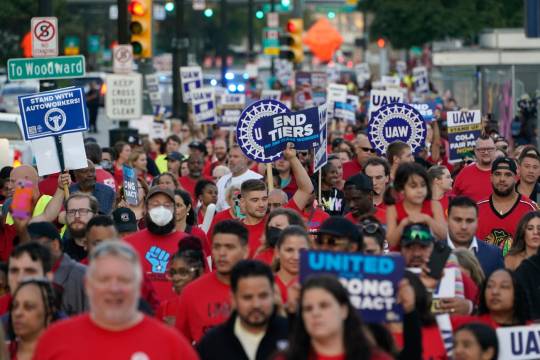
By analyzing the Federal Reserve's Survey of Consumer Finances, CAP found that in 2022, union households held $338,482 in median wealth. Meanwhile, nonunion households had $199,948.
Being in a union also substantially chips away at racial and educational wealth gaps, per CAP's analysis. Black, nonunion households have a median household wealth of $61,500; meanwhile, Black union households hold around $164,6000 in median household wealth. Black workers are also more likely than workers of other races to be in a union, according to the Bureau of Labor Statistics, with their union membership rates outpacing their white, Asian, and Hispanic counterparts.
Unions particularly pay off for workers without a high school degree and again seem to be bridging educational wealth gaps, per the data. The median wealth of union members without a high school degree is over three times that of nonunion workers without a high school degree — $69,510 compared to $22,800 respectively.
Unions work, Unionize.
Source: Juliana Kaplan, Business Insider, Mar 21, 2024.
872 notes
·
View notes
Text
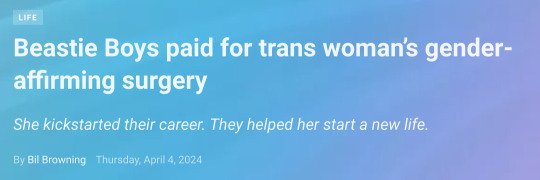

Donna Lee Parsons isn’t particularly well-known in hardcore/punk circles, but she should be. She played a pivotal role in rock history.
Before she transitioned, she founded Rat Cage Records, a record label that released the Beastie Boys’ first two EPs; she signed them at their very first show. Twenty years later, after Parsons came out as trans and the band’s meteoric rise to fame, the artists quietly paid for Parson’s gender affirmation surgery.
According to member Adam Horovitz, since the men knew she wouldn’t accept the money if she saw it as a charitable act, they claimed they owed her royalties from their EP Polly Wog Stew.
[...]
So if you’ve ever worn a ‘lightning bolt’ t-shirt or listened to Victim in Pain or found yourself fondly recalling a Beastie Boys show you went to, you have a transgender woman to thank for that. And we should know her story. If you call yourself a hardcore kid, Donna Lee Parsons touched your life.
Source: LGBTQ Nation | True Trans Soul Rebel by Norman Brannon | April 2024
19K notes
·
View notes
Text


By analyzing the Federal Reserve's Survey of Consumer Finances, CAP found that in 2022, union households held $338,482 in median wealth. Meanwhile, nonunion households had $199,948.
Being in a union also substantially chips away at racial and educational wealth gaps, per CAP's analysis. Black, nonunion households have a median household wealth of $61,500; meanwhile, Black union households hold around $164,6000 in median household wealth. Black workers are also more likely than workers of other races to be in a union, according to the Bureau of Labor Statistics, with their union membership rates outpacing their white, Asian, and Hispanic counterparts.
Unions particularly pay off for workers without a high school degree and again seem to be bridging educational wealth gaps, per the data. The median wealth of union members without a high school degree is over three times that of nonunion workers without a high school degree — $69,510 compared to $22,800 respectively.
Unions work, Unionize.
Source: Juliana Kaplan, Business Insider, Mar 21, 2024.
872 notes
·
View notes
Text
Early this week, the HELP Committee released a report that found Bristol Myers Squibb, Johnson & Johnson and Merck spend more on executive compensation, stock buybacks and dividends than they do on research and development.
"In other words, these companies are spending more to enrich their own stockholders and CEOs than they are in finding new cures and new treatments," Bernie Sanders reiterated in his opening statement at the hearing. "Now, the average American who hears all this is asking a very simple question. How does all of this happen?"
216 notes
·
View notes
Text
"[Kissinger] is one of the most destructive secretaries of state of the modern history of this country [...] I am proud to say that Henry Kissinger is not my friend. I will not take advice from Henry Kissinger.
[The Cambodian Genocide] was one of the worst genocides in the history of the world, So, count me in as somebody who will not be listening to Henry Kissinger." — Bernie Sanders (2016)
Henry Kissinger (1923 - November 29, 2023)
"Once you’ve been to Cambodia, you’ll never stop wanting to beat Henry Kissinger to death with your bare hands. You will never again be able to open a newspaper and read about that treacherous, prevaricating, murderous scumbag sitting down for a nice chat with Charlie Rose or attending some black-tie affair for a new glossy magazine without choking. Witness what Henry did in Cambodia – the fruits of his genius for statesmanship – and you will never understand why he’s not sitting in the dock at The Hague next to Milošević." — Anthony Bourdain
Henry Kissinger (1923 - November 29, 2023)
3K notes
·
View notes
Text
Bernie Sanders intervenes and stops GOP senator from fighting a witness
Sen. Markwayne Mullin (R-OK) challenged Teamsters General President Sean M. O'Brien to a fight during a Senate hearing.
158 notes
·
View notes
Text
I've seen a number of people on here proclaim that you should not, under no circumstances, take photos at a protest, but: Sharing photos of protests is a great way to amplify the impact of collective action, raise awareness on important issues, and encourage more people to participate.
But: We also have to keep in mind that surveillance is on the rise, including the use of facial recognition tech, which can put people at risk.
So here is a quick basic guide, courtesy of DigitalRightsWatchAU, to protecting people's biometric data when posting protest photos:
Conceal or obscure people’s faces in photos
Before you upload photos from protests to social media, remove biometric data by concealing or obscuring people’s faces and using proper communication channels.
Use Signal.
Signal is a great encrypted messaging app that protects your communications. It also has an in-built feature to blur out people’s faces.
We strongly recommend using Signal to communicate with people white protesting (and anytime, really!), and this added feature makes it easy to protect the identities of people in your photos.
Be selective – choose photos that don’t show people’s faces.
With some careful photography and curation, you can upload photos that capture the scale and energy of a protest without revealing sensitive information — no need to edit them!
Here are some ideas:
take photos at a distance, capturing the crowd rather than individual details of faces,
position yourself behind the march, showing only the backs of heads,
focus on signs, flags and other details to emphasise the protest vibe without showing people’s faces.
Remember it’s good practice to ask people before taking their photo whenever you can. You can also explain to them that you just want to get their sign or outfit but not their face – let them know you want to protect their privacy!
Extra tips:
Doing this does not remove the metadata from your image. Image metadata is generated automatically and usually includes details including the time, date, and GPS location, and information about the type of phone used – this can be used to pinpoint where you were and when. To easily remove metadata, take a screenshot on your device and delete the original.
For extra protection, delete the original photos that show people’s faces from your phone after you have made a version that obscures the faces. Even if you don’t intend to upload them online, if your device is compromised or unlocked and you have the originals sitting there, you’ve done all that work for nothing!
What about videos? Videos are trickier to edit to hide people’s faces and may require additional time, effort and software – this isn’t always possible while you’re on the go! We suggest focusing on minimising capturing faces in the first place when recording video footage.
Focus on harm minimisation rather than perfection. Taking protest photos without revealing people’s faces can be hard – there are a lot of people moving around which makes it difficult. The goal is to minimise sharing others’ biometric information as much as possible. Just try your best!
When you want to capture details: recording incidents
Recording incidents such as use of violence by law enforcement can be a powerful tool of accountability. It pays to be prepared.
Here are some tips from Melbourne Activist Legal Support on observing police at protests:
Record in landscape mode. It captures more of the scene.
Hold your device steady and move it slowly. Smooth, clear footage makes better evidence.
If taking your phone to an action, make sure you don’t take sensitive data with you.
Context is important. Recording moments before an arrest can be as important as the arrest itself.
Try to take clear steady images that capture the police officer’s badge name or ID number.
Don’t hinder an arrest when observing or you may end up arrested too.
Try not to narrate. Your recording may not capture key information if you’re speaking over it.
Police do not have the right to hinder you recording public interactions.
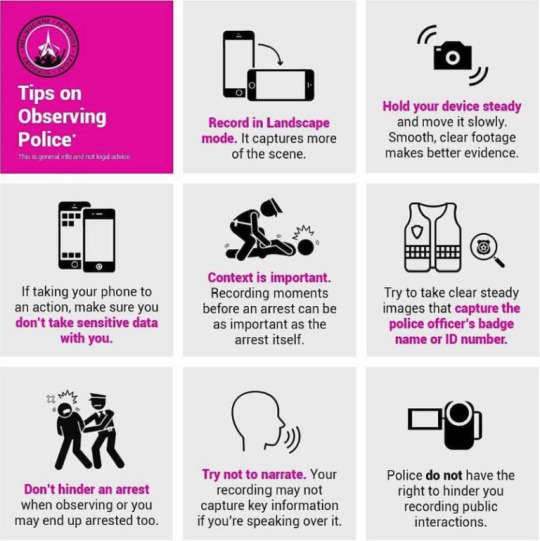
You can also check out the resources from Witness for in-depth guides to recording incidents to protect and uphold human rights. You can also get advice and tools from the National Justice Project’s CopWatch.
265 notes
·
View notes
Text


The United States is about to embark on an experiment inspired by one of the New Deal’s most popular programs. On Wednesday, the Biden administration authorized the creation of the American Climate Corps through an executive order. The program would hire 20,000 young people in its first year, putting them to work installing wind and solar projects, making homes more energy-efficient, and restoring ecosystems like coastal wetlands to protect towns from flooding. ¹
Rep. Joe Neguse, a Colorado Democrat, said the program should pay “a living wage” while offering health care coverage and other benefits. ²
There are plans to link it with AmeriCorps, the national service program, and leverage several smaller climate corps initiatives that states have launched in California, Colorado, Maine, Michigan, and Washington. The White House also launched a new website where you can sign up to get updates about joining the program. ¹
The American Climate Corps is an interagency partnership between AmeriCorps, National Oceanic and Atmospheric Administration (NOAA) and the Departments of Labor, Interior, Agriculture, and Energy.³
Reviving the Civilian Conservation Corps is widely popular, with 84 percent of Americans supporting the idea in polling conducted by the Yale Program on Climate Change Communication last year. ¹
¹ Grist, Sep. 20ᵗʰ 2023 ² Boston, Sept. 21ˢᵗ. 2023 ³ AmeriCorps, Sept. 20ᵗʰ 2023
971 notes
·
View notes
Text
CNN | United Auto Workers members walked off the job and joined picket lines at midnight Friday morning.
#politics#the left#strike#progressive#progressive mo#progressive movement#labor unions#unions#workers rights#labor movement#video#cnn
233 notes
·
View notes
Text
youtube
Just Have A Think | Geothermal is going global!
#politics#the left#climate change#climate crisis#renewableenergy#just have a think#youtube#video#progressive#geothermal power#Youtube
15 notes
·
View notes
Text
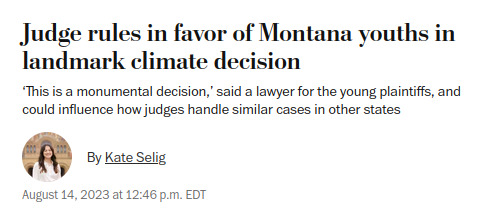
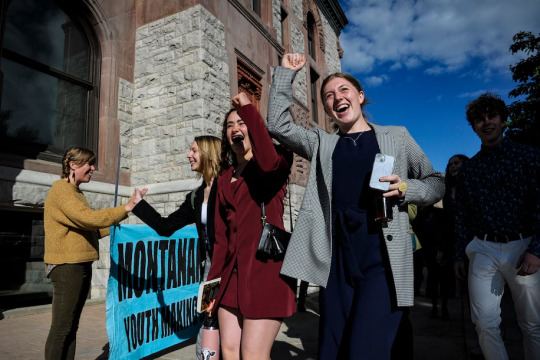
In the first ruling of its kind nationwide, a Montana state court decided Monday in favor of young people who alleged the state violated their right to a “clean and healthful environment” by promoting the use of fossil fuels.
The court determined that a provision in the Montana Environmental Policy Act has harmed the state’s environment and the young plaintiffs, by preventing Montana from considering the climate impacts of energy projects. The provision is accordingly unconstitutional, the court said.
The win, experts say, could energize the environmental movement and reshape climate litigation across the country, ushering in a wave of cases aimed at advancing action on climate change.
(Source: Washington Post, August 2023)
2K notes
·
View notes
Text
youtube
PBS Terra | Will Climate Change Pop the Housing Bubble?
18 notes
·
View notes
Quote
For organized blocs involved in trying to influence this “party of the people” from within, politics are reduced to pressure tactics. For organized labor, in particular, attempts to influence the policies and practices of elected Democratic officials are reduced to financial donations (which often pale in comparison to those from capital), endorsements, and get-out-the-vote efforts on behalf of favored individual candidates. This is followed by lobbying in hopes of getting them to actually support labor’s goals–mostly directed from the top of the unions. The process is, in practice, analogous to the collective bargaining with which these leaders are familiar. It involves negotiation, occasional temporary mobilization, and compromise. The difference is that in collective bargaining, the mobilization phase can involve the withdrawal of labor, which can temporarily cripple the employer. There is no such force available in conventional politics other than the idle threat to withdraw labor’s votes.
On New Terrain: How Capital Is Reshaping The Battleground of Class War, by Kim Moody
(via
berniesrevolution
)
65 notes
·
View notes
Text
youtube
Money & Macro | How Austerity Ruined Britain's Economy
19 notes
·
View notes
Photo
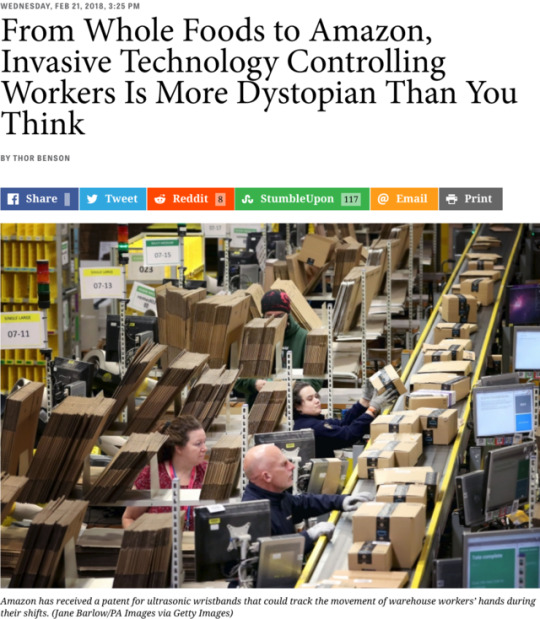
IN THESE TIMES
You’ve been fired. According to your employer’s data, your facial expressions showed you were insubordinate and not trustworthy. You also move your hands at a rate that is considered substandard. Other companies you may want to work for could receive this data, making it difficult for you to find other work in this field.
That may sound like a scenario straight out of a George Orwell novel, but it’s the future many American workers could soon be facing.
In early February, media outlets reported that Amazon had received a patent for ultrasonic wristbands that could track the movement of warehouse workers’ hands during their shifts. If workers’ hands began moving in the wrong direction, the wristband would buzz, issuing an electronic corrective. If employed, this technology could easily be used to further surveil employees who already work under intense supervision.
Whole Foods, which is now owned by Amazon, recently instituted a complex and punitive inventory system where employees are graded based on everything from how quickly and effectively they stock shelves to how they report theft. The system is so harsh it reportedly causes employees enough stress to bring them to tears on a regular basis.
UPS drivers, who often operate individually on the road, are now becoming increasingly surveilled. Sensors in every UPS truck track when drivers’ seatbelts are put on, when doors open and close and when the engines start in order to monitor employee productivity at all times.
The technology company Steelcase has experimented with monitoring employees’ faces to judge their expressions. The company claims that this innovation, which monitors and analyzes workers’ facial movements throughout the work day, is being used for research and to inform best practices on the job. Other companies are also taking interest in this kind of mood-observing technology, from Bank of America to Cubist Pharmaceuticals Inc.
These developments are part of a larger trend of workers being watched and judged—often at jobs that offer low pay and demand long hours. Beyond simply tracking worker performance, it is becoming more common for companies to monitor the emails and phone calls their employees make, analyzing personal traits along with output.
Some companies are now using monitoring techniques—referred to as “people analytics”—to learn as much as they can about you, from your communication patterns to what types of websites you visit to how often you use the bathroom. This type of privacy invasion can cause employees immense stress, as they work with the constant knowledge that their boss is aware of their every behavior—and able to use that against them as they see fit.
Lewis Maltby, president of the National Workrights Institute at Cornell University, tells In These Times that the level of surveillance workers are facing is increasing exponentially.
“If you look at what some people call ‘people analytics,’ it’s positively frightening,” Maltby says. “People analytics devices get how often you talk, the tone of your voice, where you are every single second you’re at work, your body language, your facial expressions and something called ‘patterns of interaction.’” He explains that some of these devices even record what employees say at work.
(Continue Reading)
71K notes
·
View notes
Photo

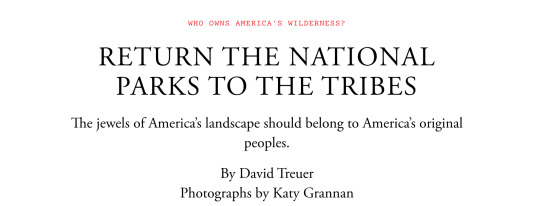
The Atlantic

in 1851, members of a California state militia called the Mariposa Battalion became the first white men to lay eyes on Yosemite Valley. The group was largely made up of miners. They had been scouring the western slopes of the Sierra when they happened upon the granite valley that Native peoples had long referred to as “the place of a gaping mouth.” Lafayette Bunnell, a physician attached to the militia, found himself awestruck. “None but those who have visited this most wonderful valley, can even imagine the feelings with which I looked upon the view,” he later wrote. “A peculiar exalted sensation seemed to fill my whole being, and I found my eyes in tears.” Many of those who have followed in Bunnell’s footsteps over the past 170 years, walking alongside the Merced River or gazing upon the god-rock of El Capitan, have been similarly struck by the sense that they were in the presence of the divine.
The Mariposa Battalion had come to Yosemite to kill Indians. Yosemite’s Miwok tribes, like many of California’s Native peoples, were obstructing a frenzy of extraction brought on by the Gold Rush. And whatever Bunnell’s fine sentiments about nature, he made his contempt for these “overgrown, vicious children” plain:
Any attempt to govern or civilize them without the power to compel obedience, will be looked upon by barbarians with derision … The savage is naturally vain, cruel and arrogant. He boasts of his murders and robberies, and the tortures of his victims very much in the same manner that he recounts his deeds of valor in battle.
When the roughly 200 men of the Mariposa Battalion marched into Yosemite, armed with rifles, they did not find the Miwok eager for battle. While the Miwok hid, the militiamen sought to starve them into submission by burning their food stores, souring the valley’s air with the smell of scorched acorns. On one particularly bloody day, some of the men came upon an inhabited village outside the valley, surprising the Miwok there. They used embers from the tribe’s own campfires to set the wigwams aflame and shot at the villagers indiscriminately as they fled, murdering 23 of them. By the time the militia’s campaign ended, many of the Miwok who survived had been driven from Yosemite, their homeland for millennia, and forced onto reservations.
Thirty-nine years later, Yosemite became the fifth national park. (Yellowstone, which was granted that status in 1872, was the first.) The parks were intended to be natural cathedrals: protected landscapes where people could worship the sublime. They offer Americans the thrill of looking back over their shoulder at a world without humans or technology. Many visit them to find something that exists outside or beyond us, to experience an awesome sense of scale, to contemplate our smallness and our ephemerality. It was for this reason that John Muir, the father of modern conservationism, advocated for the parks’ creation.
More than a century ago, in the pages of this magazine, Muir described the entire American continent as a wild garden “favored above all the other wild parks and gardens of the globe.” But in truth, the North American continent has not been a wilderness for at least 15,000 years: Many of the landscapes that became national parks had been shaped by Native peoples for millennia. Forests on the Eastern Seaboard looked plentiful to white settlers because American Indians had strategically burned them to increase the amount of forage for moose and deer and woodland caribou. Yosemite Valley’s sublime landscape was likewise tended by Native peoples; the acorns that fed the Miwok came from black oaks long cultivated by the tribe. The idea of a virgin American wilderness—an Eden untouched by humans and devoid of sin—is an illusion.
(Continue Reading)
475 notes
·
View notes



